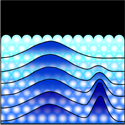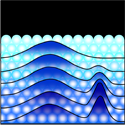Insulating behavior is only skin deep
In a Mott insulator, the electrons can form an insulating state despite the fact that band theory says it should be a conductor. Some of the most interesting materials —high- superconductors and colossal magnetoresistive oxides—are examples of Mott insulators.
Theory predicts that electron correlations in (a prototype Mott compound) form, in its metallic phase, composite entities at the Fermi energy called quasiparticles, which have a large effective mass. As the material temperature changes to induce a metal-insulator transition, these quasiparticle states ultimately disappear.
Angle-resolved photoemission spectroscopy (ARPES) is a technique that can, in principle, directly measure the electronic structure predicted by theory but the measurements are not easy [1]. The generally accepted explanation for this difficulty was that because atoms at a free surface undergo restructuring, stronger electron-electron correlations over a region near the surface form an insulating atomically thin layer, even when the bulk is still a metal.
In Physical Review Letters, a joint experimental and theoretical effort proposes that the insulating surface layer in and other metals near a Mott transition could generally constitute a much wider “dead layer” whose thickness is more a property of the bulk than of the surface. Fanny Rodolakis and colleagues at Université Paris-Sud in Orsay, France, and collaborators elsewhere in France and Italy present bulk-sensitive ARPES results showing that the dead layer extends further than expected from just the surface itself and the thickness of this layer increases as the temperature approaches the metal-insulator transition. Calculations presented by Giovanni Borghi and colleagues at SISSA, at the ICTP and at CNR/INFM Democritos in Trieste, Italy, suggest that the important length scale is in fact not the atomic thickness of the surface, but an intrinsic length scale that depends critically on the proximity to the metal-insulator transition.
The idea may explain ARPES measurements of other materials where the surface dead layer seemed larger than expected. – Jessica Thomas
[1] S.-K. Mo et al., Phys. Rev. Lett. 90, 186403 (2003).





